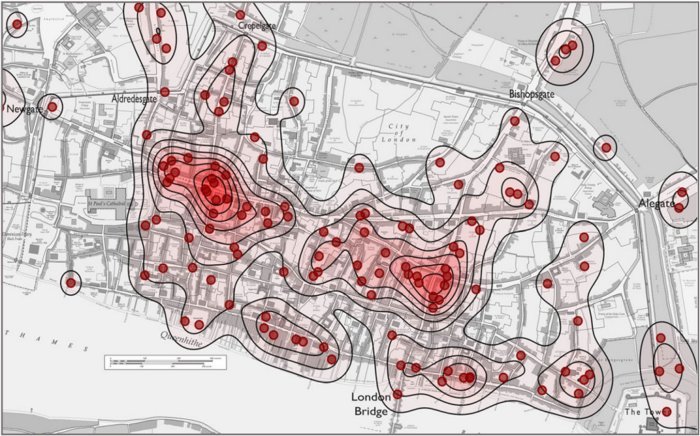Jan Bartek – AncientPages.com – One of the intriguing unsolved medieval murder cases in 14th-century England involves the assassination of a priest near St Paul’s Cathedral in 1337.
The question arises: why would a noblewoman commit such an act? Possible motives include revenge, jealousy, or slander. Professor Manuel Eisner, a criminologist from Cambridge, has discovered new evidence that may illuminate the reasons behind the murder of Priest John Forde’s murder on a bustling London street nearly seven centuries ago.
Professor Eisner proposes that Forde’s death was a revenge killing orchestrated by Ela Fitzpayne, a noblewoman subjected to years of humiliating penance after being exposed as having an affair with Forde, possibly revealed by Forde himself. A letter from the Archbishop five years prior accuses Fitzpayne of multiple adulteries, including one with John Forde, and mandates she perform barefoot walks of shame at Salisbury Cathedral.

Additional records uncovered by Eisner indicate that during this period, Ela Fitzpayne conspired with her husband and John Forde to lead an extortionist gang targeting church properties. Although explicit connections remain elusive, these documents suggest that John Forde transitioned from being part of Ela Fitzpayne’s criminal activities and possibly her lover to becoming involved in her denunciation by the church, and ultimately becoming a murder victim. Notably, one of his killers was identified as Ela Fitzpayne’s brother, and two others as her recent servants.
According to Professor Eisner’s findings, this bold murder might have been intended as a demonstration of power—a reminder to the clergy about the enduring influence and memory of nobility like Ela Fitzpayne.
Digital copies of the coroner report and letters are published together for the first time on the University’s website. A new paper on the Medieval Murder Maps is published in Criminal Law Forum, and a series of podcasts are available, with each episode taking an in-depth look at an individual case, including that of Forde and Fitzpayne.
“We are looking at a murder commissioned by a leading figure of the English aristocracy. It is planned and cold-blooded, with a family member and close associates carrying it out, all of which suggests a revenge motive,” said Professor Eisner.
“Attempts to publicly humiliate Ela Fitzpayne may have been part of a political game, as the church used morality to stamp its authority on the nobility, with John Forde caught between masters.
Taken together, these records suggest a tale of shakedowns, sex and vengeance that expose tensions between the church and England’s elites, culminating in the mafia-style assassination of a fallen man of god by a gang of medieval hitmen,” Professor Eisner added.
Professor Eisner oversees the Medieval Murder Maps, a digital initiative that charts crime scenes using translations of coroners’ rolls from the 14th century. So far, this project has developed maps for London, Oxford, and York. These rolls, originally written in Latin, document sudden or suspicious deaths investigated by a jury of local men convened by the coroner to ascertain facts and deliver a verdict—a fundamental aspect of medieval justice. Typically composed of about twelve men, some juries included witnesses.
Notably, the jury for Forde’s murder comprised 33 men—one of the largest in any case mapped by this project—indicating that both the sheriff and coroner regarded it as particularly significant.
Westcheap – A Homicide ‘Hotspot’
The jury documented that John Forde was walking along Cheapside after vespers but before sunset on Friday, May 3rd, 1337, when he was engaged in “pleasant conversation” by fellow priest Hasculph Neville.
As they neared St Paul’s, four men, including Hugh Lovell—brother of Ela Fitzpayne—attacked Forde. Lovell used a 12-inch dagger to fatally wound Forde by cutting his throat, while two others, Hugh Colne and John Strong (former employees of the Fitzpaynes), stabbed him in the abdomen.

Map of homicide ‘hotspots’ in medieval London. Credit: Cambridge University
The jury members, which included a rosary-maker and a hatmaker, identified all attackers but claimed ignorance regarding their current locations. They also noted an ongoing feud between the Fitzpaynes and Forde.
“Despite naming the killers and clear knowledge of the instigator, when it comes to pursuing the perpetrators the jury turn a blind eye,” said Eisner.
“A household of the highest nobility, and apparently no one knows where they are to bring them to trial. They claim Ela’s brother has no belongings to confiscate. All implausible. This was typical of the class-based justice of the day.”
In 1342, former Fitzpayne servant Colne was charged and imprisoned in Newgate for a crime committed five years earlier, marking the only indictment in the case. The incident occurred in Westcheap, identified as London’s most notable medieval homicide hotspot according to recent research findings.
This area was bustling with markets, taverns, alehouses, and influential guilds like those of goldsmiths and saddlers. It served as a hub of trade and social activity where situations could easily escalate into violence. Conflicts often arose from disputes among merchants or artisans and group altercations between guild apprentices resembling modern-day gang turf wars. Historical records also indicate that Westcheap witnessed several premeditated revenge killings, including the one that resulted in John Forde’s death.
“Westcheap was a site for displays of civic justice, such as the pillory or stocks,” said Professor Eisner. “As a setting for public rituals of punishment, this appears to have included extrajudicial killings.”
The Archbishop’s Letters Reveal Much But Was It True?
In examining the Forde case, Professor Eisner discovered a letter from Simon Mepham, the Archbishop of Canterbury, addressed to the Bishop of Winchester in January 1332. The letter accused Ela Fitzpayne of engaging in sexual relationships with various individuals, including knights and clerics.
As punishment for her actions, Ela was prohibited from wearing gold, pearls, or precious stones. She was required to make substantial financial contributions to monastic orders and charitable donations to the poor. Her most notable penance involved a public walk of shame along the nave of Salisbury Cathedral—the longest in England—barefoot while carrying a four-pound wax candle to the altar each autumn for seven years.

The letters from the Archbishop of Canterbury to the Bishop of Winchester regarding Ela Fitzpayne are documented in the register of John de Stratford Reproduced with permission of Hampshire Archives and Hampshire County Council.
The correspondence also reveals that Fitzpayne was driven by pride and allegedly influenced by malevolent forces, as she refused these penances and abandoned her husband. A subsequent letter from April reported that Ela was hiding in Rotherhithe within the Diocese of Winchester and had been excommunicated. Among her alleged lovers mentioned in these letters is John Forde, who is believed to have informed the Archbishop about Ela’s conduct. At that time, Forde served as rector at Okeford Fitzpaine church on the Fitzpayne family’s Dorset estate.
“The archbishop imposed heavy, shameful public penance on Ela, which she seems not to have complied with, but may have sparked a thirst for vengeance,” said Eisner. “Not least as John Forde appears to have escaped punishment by the church.”
Priory Raiders
In March 1322, historical records indicate that Ela Fitzpayne and John Ford were indicted by a Royal Commission. The previous year, they had participated in a raid on a Benedictine priory alongside Sir Robert Fitzpayne, Ela’s husband and the lord of Stogursey Castle. During this raid, the group damaged priory gates and buildings, cut down trees, and looted the quarry. They also seized up to 18 oxen, 30 pigs, and approximately 200 sheep and lambs before transporting them back to the castle.
The priory was an extension of a French abbey at a time when tensions between France and England were escalating. King Edward III had recently ascended to the English throne and was pursuing his claim to the French crown. This period of hostility eventually led to the outbreak of the Hundred Years’ War by 1337—the same year John Ford was murdered.
Ford’s parish was around fifty miles from Stogursey. “Ela would have visited Okeford, and Forde may have spent significant time at the castle,” said Professor Eisner. He suggests that Forde colluded with the Fitzpaynes to take advantage of diplomatic tensions by raiding the priory.
“John Forde may have had split loyalties,” said Professor Eisner. “One to the Fitzpayne family, who were likely patrons of his church and granted him the position. And the other to the bishops who had authority over him as a clergy member.”

Credit: Cambridge University
“We know that Archbishop Mepham was keen to enforce moral discipline among the gentry and nobility, and act against those who displayed moral failings,” said Eisner.
“Taking part in the raid would have shown Forde’s loyalty to the Fitzpaynes rather than the church, which would not have gone down well with the Archbishop.”
Ford may have confessed his liaison with Ela, perhaps under pressure following the raid. The Archbishop then weaponised sexual slander to pronounce humiliating punishment on a high-ranking noblewoman who defied the moral authority of the church.
“Public humiliation can have poisonous effects, breeding hatred and revenge in humans both today and in the distant past,” said Professor Eisner in a press release.
“Feeling humiliated motivates wars, extremism, mass killings, and here it’s probably a motivation for assassination. Humiliation creates emotions of anger and shame in the short term. Over time this can harden into a desire for violence.”
In 1333, the Archbishop passed away, but Ela Fitzpayne waited four more years before exacting revenge on John Forde. She orchestrated his killing with the help of her brother and other associates in a public setting near St. Paul’s, witnessed by crowds. According to a Cambridge criminologist, this public execution style mirrors modern political killings seen in countries like Russia or Mexico, serving as a stark reminder of who holds power.
In societies where the rule of law is weak, such acts are often carried out by those at the highest levels of society who choose to assert their authority directly, whether today or seven centuries ago.
See also: More Archaeology News
Interestingly, there is no evidence of conflict between Ela and her second husband, Robert Fitzpayne—a baron and early parliamentarian. Robert remained married to Ela until his death in 1354, after which she inherited all his property.
“A woman in 14th century England who raided priories, openly defied the Archbishop of Canterbury, and planned the assassination of a priest. Ela Fitzpayne appears to have been many things, including an extraordinary person,” Professor Esiner added.
Written by – Jan Bartek – AncientPages.com Staff Writer









